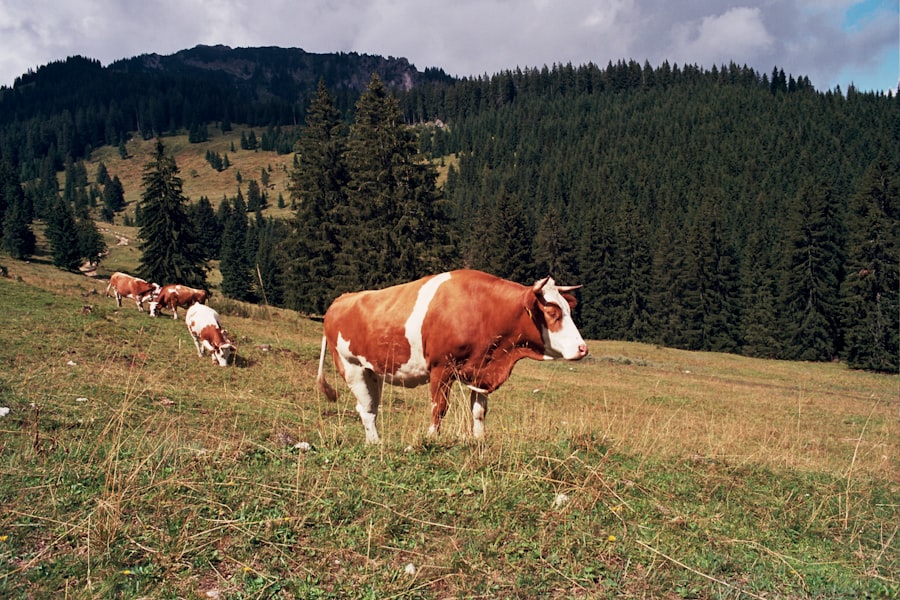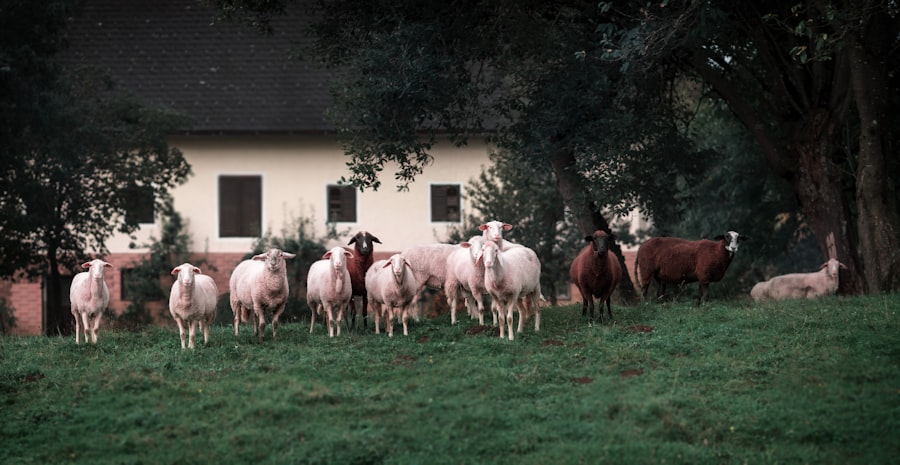Integrating chickens and goats on a farm or homestead offers numerous advantages. These two livestock species can provide a diverse range of products, including eggs, meat, milk, and natural pest control. When properly managed, chickens and goats can coexist in a mutually beneficial relationship.
Chickens help control insects and parasites that may affect goats, while goats can provide protection for chickens against predators. Additionally, chicken manure can serve as a valuable fertilizer for pastures where goats graze. However, there are potential challenges and risks associated with keeping these animals together.
Goats may accidentally injure chickens by stepping on them or consuming their feed. Chickens can potentially spread diseases to goats, and vice versa. To mitigate these risks, farmers should implement proper housing arrangements, separate feeding areas, and maintain good hygiene practices.
Successful integration requires careful planning and management. Providing adequate space, appropriate fencing, and separate shelter areas for each species is essential. Regular health checks, proper nutrition, and vaccination programs are crucial for maintaining the well-being of both chickens and goats.
By addressing these considerations, farmers can create a harmonious and productive environment that maximizes the benefits of keeping these two valuable livestock species together.
Table of Contents
- 1 Benefits of keeping chickens and goats together
- 2 Potential risks and challenges of keeping chickens and goats together
- 3 Best practices for keeping chickens and goats together
- 4 Tips for maintaining a safe and healthy environment for chickens and goats
- 5 Common misconceptions about keeping chickens and goats together
- 6 Is it safe to keep chickens with goats?
- 7 FAQs
- 7.1 What are the benefits of keeping chickens with goats?
- 7.2 Are there any risks to keeping chickens with goats?
- 7.3 What precautions should be taken when keeping chickens with goats?
- 7.4 Can chickens and goats coexist peacefully?
- 7.5 What are some considerations for keeping chickens and goats together?
Key Takeaways
- Keeping chickens and goats together can be a beneficial and rewarding experience for homesteaders and small farmers.
- Benefits of keeping chickens and goats together include pest control, waste management, and a symbiotic relationship between the two species.
- Potential risks and challenges of keeping chickens and goats together include disease transmission, competition for resources, and potential for injury.
- Best practices for keeping chickens and goats together include providing separate housing, monitoring for signs of stress or illness, and maintaining a clean and safe environment.
- Tips for maintaining a safe and healthy environment for chickens and goats include regular health checks, proper nutrition, and predator-proofing the living area.
- Common misconceptions about keeping chickens and goats together include the belief that they can freely roam together without any issues.
- In conclusion, with proper planning and management, it is safe to keep chickens with goats, and the benefits of their cohabitation can outweigh the potential risks.
Benefits of keeping chickens and goats together
Mutual Benefits
Chickens are natural foragers and can help keep the goat pasture free of insects, ticks, and other pests. In return, goats can provide a source of warmth and protection for the chickens, especially during cold weather or in predator-prone areas.
Sustainable Farming
The manure produced by both chickens and goats can be used to fertilize the soil, creating a more sustainable and productive farming environment. Furthermore, both chickens and goats can provide valuable products for the farm, such as eggs, meat, milk, and fiber, allowing for a diverse and self-sustaining agricultural operation.
Efficient Farm Management
By integrating these two species, farmers can make the most of their resources and space, as both chickens and goats have different dietary needs and grazing habits. For example, goats are known for their ability to browse on shrubs and weeds, while chickens excel at scratching and pecking for insects in the soil. This complementary behavior can help maximize the use of pasture and forage, leading to a more productive and sustainable farming system.
Potential risks and challenges of keeping chickens and goats together

While there are many benefits to keeping chickens and goats together, there are also potential risks and challenges that must be considered. One of the main concerns is the potential for disease transmission between the two species. Chickens are susceptible to certain diseases that can be carried by goats, such as caprine arthritis encephalitis (CAE) or caseous lymphadenitis (CL).
Similarly, goats can be affected by diseases carried by chickens, such as coccidiosis or blackhead. To mitigate this risk, it is important to practice good biosecurity measures, such as keeping feed and water separate for each species, regularly cleaning and disinfecting shared spaces, and monitoring the health of both chickens and goats closely. Another challenge of keeping chickens and goats together is the potential for competition over resources, such as food, water, and shelter.
Chickens are known to be opportunistic feeders and may try to steal goat feed if given the chance. Similarly, goats may bully or intimidate chickens, especially if space is limited. To address this challenge, it is important to provide ample space and resources for both species, as well as to observe their interactions closely to ensure that each animal has access to what they need.
Best practices for keeping chickens and goats together
To successfully keep chickens and goats together, it is important to follow best practices for management and husbandry. One key practice is to provide separate housing for each species, with secure fencing to prevent intermingling. This will help reduce the risk of disease transmission and minimize competition over resources.
Additionally, it is important to provide ample space for both chickens and goats to roam and forage, as well as access to fresh water and appropriate feed for each species. Another best practice is to monitor the health of both chickens and goats regularly and to seek veterinary care as needed. This includes implementing a vaccination program for both species, as well as deworming and parasite control measures.
By staying proactive about animal health, farmers can help prevent disease outbreaks and ensure the well-being of their livestock.
Tips for maintaining a safe and healthy environment for chickens and goats
In addition to following best practices for management, there are several tips for maintaining a safe and healthy environment for chickens and goats. One tip is to provide adequate shelter and protection from predators for both species. This may include secure coops for chickens at night and sturdy fencing to keep out predators such as foxes or raccoons.
Similarly, goats may benefit from a guardian animal, such as a livestock guardian dog or donkey, to help protect them from predators. Another tip is to provide a balanced diet for both chickens and goats, taking into account their specific nutritional needs. This may include offering supplemental feed for chickens to ensure they receive enough protein, as well as providing access to mineral supplements for goats to support their overall health.
Additionally, it is important to rotate grazing areas regularly to prevent overgrazing and reduce the risk of parasite infestations.
Common misconceptions about keeping chickens and goats together

Coexistence Without Harm
One common misconception about keeping chickens and goats together is that they will harm each other, particularly that chickens will harm goat kids or vice versa. However, in most cases, these animals can coexist peacefully without causing harm to one another, as long as their interactions are closely monitored.
Managing Resources
Another misconception is that chickens will eat goat feed or vice versa, leading to competition over resources. This can be easily avoided by providing separate feeding areas for each species and closely monitoring their access to feed.
Disease Prevention and Management
A third common misconception is that keeping chickens and goats together will lead to an increase in disease outbreaks. While there is a risk of disease transmission between the two species, this can be mitigated through good management practices and regular health monitoring. By following best practices for biosecurity and animal health, farmers can reduce the risk of disease outbreaks and maintain a safe environment for both chickens and goats.
Is it safe to keep chickens with goats?
In conclusion, keeping chickens and goats together can be a beneficial practice when managed properly. By understanding the potential risks and challenges, following best practices for management, and implementing tips for maintaining a safe environment, farmers can successfully integrate these two species on their farm or homestead. The symbiotic relationship between chickens and goats can lead to increased efficiency in farm management, as well as provide valuable products for the farm.
While there are misconceptions about keeping chickens and goats together, with proper care and attention, it is indeed safe to keep these two species together in a shared environment.
If you’re considering keeping chickens and goats together, you may also be interested in learning about the best chicken coop and run plans. Check out this article for some helpful tips and ideas on creating a safe and functional space for your chickens.
FAQs
What are the benefits of keeping chickens with goats?
Keeping chickens with goats can have several benefits. Chickens can help control pests such as ticks and flies around the goat area. They can also help with waste management by eating leftover goat feed and turning it into eggs. Additionally, chickens and goats can provide companionship for each other.
Are there any risks to keeping chickens with goats?
While there are benefits to keeping chickens with goats, there are also potential risks. Chickens can be vulnerable to being stepped on or injured by goats, especially if they are not provided with adequate space and shelter. Additionally, goats can be carriers of diseases that may be harmful to chickens.
What precautions should be taken when keeping chickens with goats?
To minimize risks, it is important to provide separate housing for chickens and goats to ensure that they have their own space and are protected from potential harm. Additionally, regular health checks and vaccinations for both chickens and goats can help prevent the spread of diseases. Providing adequate space, proper nutrition, and access to clean water for both chickens and goats is also essential.
Can chickens and goats coexist peacefully?
With proper management and precautions, chickens and goats can coexist peacefully. Providing enough space, separate housing, and monitoring their interactions can help minimize potential conflicts. It is important to observe the behavior of both chickens and goats to ensure that they are getting along and not causing harm to each other.
What are some considerations for keeping chickens and goats together?
When considering keeping chickens and goats together, it is important to assess the space available, the temperament of the animals, and the resources needed to care for both species. Additionally, understanding the specific needs and behaviors of chickens and goats can help in creating a suitable environment for them to coexist. Regular monitoring and adjustments may be necessary to ensure the well-being of both chickens and goats.
Meet Walter, the feathered-friend fanatic of Florida! Nestled in the sunshine state, Walter struts through life with his feathered companions, clucking his way to happiness. With a coop that’s fancier than a five-star hotel, he’s the Don Juan of the chicken world. When he’s not teaching his hens to do the cha-cha, you’ll find him in a heated debate with his prized rooster, Sir Clucks-a-Lot. Walter’s poultry passion is no yolk; he’s the sunny-side-up guy you never knew you needed in your flock of friends!







